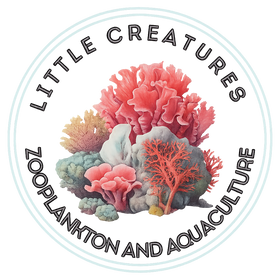Live rotifers are one of the most valuable live feeds you can introduce into a reef aquarium. Used extensively in aquaculture, coral farming, and marine fish breeding, these tiny zooplankton pack a nutritional punch that supports everything from coral growth to larval fish survival. At Little Creatures Zooplankton & Aquaculture, we specialise in culturing premium live rotifers for Australian reef keepers, breeders, and public aquariums.
---
What Are Live Rotifers?
Rotifers are microscopic aquatic invertebrates that belong to the phylum Rotifera. In the marine aquarium world, the most common species used is Brachionus plicatilis — a euryhaline rotifer that thrives in a range of salinities. Measuring between 100–250 microns, they are perfectly sized for small-mouthed marine organisms.
Rotifers are filter feeders, consuming microalgae such as Nannochloropsis or Isochrysis. When enriched with high-quality phytoplankton, they become a nutrient-rich live feed packed with proteins, lipids, and essential fatty acids.
---
Why Dose Live Rotifers in a Reef Aquarium?
1. Superior Nutrition for Corals
Corals benefit from both photosynthesis and direct feeding. While light provides energy, live rotifers deliver nitrogen, phosphorus, and fatty acids essential for tissue growth and repair. Regular rotifer dosing can lead to faster growth rates, brighter pigmentation, and improved resilience to stress.
2. Perfect Size for Filter Feeders
The particle size of live rotifers makes them accessible to a wide range of marine life, including:
Small-polyp stony corals (SPS)
Large-polyp stony corals (LPS)
Non-photosynthetic corals (NPS)
Tridacna clams
Sponges, gorgonians, and feather dusters
3. Critical First Food for Marine Fish Larvae
In both professional hatcheries and hobbyist breeding setups, live rotifers are the go-to first feed for marine fish larvae. Their constant swimming motion triggers feeding responses in species such as clownfish, gobies, wrasses, and angelfish.
4. Boosting Biodiversity in Your Tank
A healthy reef thrives on microfauna diversity. Dosing rotifers can seed your tank with live plankton, enhancing natural nutrient cycling and providing a continuous live food source for copepods, amphipods, and other small organisms.
---
How to Dose Live Rotifers in Your Reef Aquarium
For corals: Add enough rotifers to lightly cloud the water during a low-flow feeding period. Resume normal circulation after 30–45 minutes.
For fish larvae: Maintain constant gentle flow and light to keep rotifers suspended and visible.
Frequency: 1–3 times per week for established reefs; daily in breeding systems.
Pro tip: Combine live rotifers with a quality phytoplankton dose to maintain their nutrition in-tank until consumed.
---
Enriching Live Rotifers
Before feeding, rotifers should be enriched with nutrient-dense microalgae. At Little Creatures, our rotifers are enriched with a blend of Nannochloropsis (rich in EPA), Tetraselmis (balanced amino acids), and Isochrysis (DHA-rich). This ensures maximum nutrition reaches your corals and fish.
---
Live Rotifers vs. Frozen or Preserved Alternatives
Feed Type Nutritional Quality Movement Shelf Life Coral/Fish Response
Live Rotifers ★★★★★ Fresh, enriched Yes Short (days) Strong feeding trigger
Frozen Rotifers ★★★ Nutrients degrade No Months Moderate
Preserved Rotifers ★★ Limited No Long Low
Nothing replicates the feeding stimulation and nutrient quality of live rotifers.
---
Little Creatures: Your Australian Source for Premium Live Rotifers
We culture our rotifers in-house for maximum freshness and quality:
Shipped live across Australia in temperature-protected packaging
Fed on premium phytoplankton blends for optimal enrichment
No chemicals or preservatives — 100% natural live feed
Suitable for reef aquariums, breeding setups, and coral propagation
---
Final Thoughts
Whether you keep a thriving coral garden, raise marine fish, or maintain a diverse mixed reef, adding live rotifers to your feeding routine is one of the most effective ways to improve health, colour, and growth in your livestock. With the right enrichment and dosing, your reef will benefit from the same feeding practices used by leading aquaculture facilities worldwide.
---

